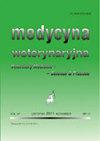侏儒兔颅、骨、股骨脱位的诊断方法和外科治疗
IF 0.4
4区 农林科学
Q4 VETERINARY SCIENCES
Medycyna Weterynaryjna-Veterinary Medicine-Science and Practice
Pub Date : 2023-01-01
DOI:10.21521/mw.6750
引用次数: 0
摘要
据我们所知,目前还没有足够的关于兔髋关节脱位的全面治疗的报道,包括使用计算机断层扫描、外科手术和术后治疗的描述,以及对结果的可测量评估。本研究的目的是报道兔髋股骨关节的计算机断层扫描检查,一种修复颅桡侧髋股骨脱位的手术技术,以及短期和长期的术后结果。经体格检查和x线检查诊断为颅桡侧共股脱位。股骨头颅侧脱位和完整的股骨颈经计算机断层扫描证实。采用颅外侧开放入路行股骨头及颈骨切除术。髋股脱位成功复位,未发生松弛。在短期和长期随访中,与临床检查并行,采用了广泛的疼痛评估方案。CT被证明是一种简单有效的技术,应考虑作为一种替代x线检查诊断兔髋股脱位。兔髋关节脱位的立即手术干预是必要的,以减轻与受伤关节运动相关的疼痛,并避免退行性变化的发展。在术后随访检查中,应通过引入术后疼痛评估方案,对术后疼痛和围手术期镇痛效果进行可靠的评估。它可以简化兔不同骨科手术结果的客观比较。本文章由计算机程序翻译,如有差异,请以英文原文为准。
Diagnostic Procedures and Surgical Treatment of Craniodorsal Coxofemoral Luxation in a dwarf rabbit
To our knowledge, there are no sufficient reports on the full management of hip luxation in rabbits, including descriptions of the diagnostics procedure with the use of computed tomography, surgical procedure, and postoperative management with a measurable assessment of the results. The objective of this study was to report on a computed tomography examination of a coxofemoral joint in a rabbit, a surgical technique for the repair of craniodorsal coxofemoral dislocation, as well as short- and long-term postoperative outcomes. Craniodorsal coxofemoral luxation was diagnosed by physical examination and radiographic examination. A craniodorsal luxation of the femoral head and the presence of an intact femoral neck were confirmed by computed tomography. An ostectomy of the femoral head and neck was performed using a craniolateral open approach. The coxofemoral luxation was successfully reduced, and reluxation did not occur. At short- and long-term follow-ups, in parallel with clinical examination, an extensive pain assessment protocol was applied. CT proved to be a simple and effective technique and should be considered as an alternative to radiographic examination for diagnosis of coxofemoral luxation in rabbits. An immediate surgical intervention in hip dislocation in rabbits is necessary to alleviate pain associated with the movement of the injured joint and to avoid development of degenerative changes. In follow-up examinations after the procedure, a reliable assessment of postoperative pain and the effectiveness of perioperative analgesia should be made by introducing a postoperative pain assessment protocol. It could simplify an objective comparison between outcomes of different orthopaedic procedures in rabbits.
求助全文
通过发布文献求助,成功后即可免费获取论文全文。
去求助
来源期刊

Medycyna Weterynaryjna-Veterinary Medicine-Science and Practice
VETERINARY SCIENCES-
CiteScore
0.80
自引率
0.00%
发文量
73
审稿时长
4-8 weeks
期刊介绍:
"Medycyna Weterynaryjna" publishes various types of articles which are grouped in the following editorial categories: reviews, original studies, scientific and professional problems, the history of veterinary medicine, posthumous memoirs, as well as chronicles that briefly relate scientific advances and developments in the veterinary profession and medicine. The most important are the first two categories, which are published with short summaries in English. Moreover, from 2001 the editors of "Medycyna Weterynaryjna", bearing in mind market demands, has also started publishing entire works in English. Since 2008 the periodical has appeared in an electronic version. The following are available in this version: summaries of studies published from 1999 to 2005, full versions of all the studies published in the years 2006-2011 (in pdf files), and full versions of the English studies published in the current year (pdf). Only summaries of the remaining studies from the current year are available. In accordance with the principles accepted by the editors, the full versions of these texts will not be made available until next year.
All articles are evaluated twice by leading Polish scientists and professionals before they are considered for publication. For years now "Medycyna Weterynaryjna" has maintained a high standard thanks to this system. The review articles are actually succinct monographs dealing with specific scientific and professional problems that are based on the most recent findings. Original works have a particular value, since they present research carried out in Polish and international scientific centers.
 求助内容:
求助内容: 应助结果提醒方式:
应助结果提醒方式:


